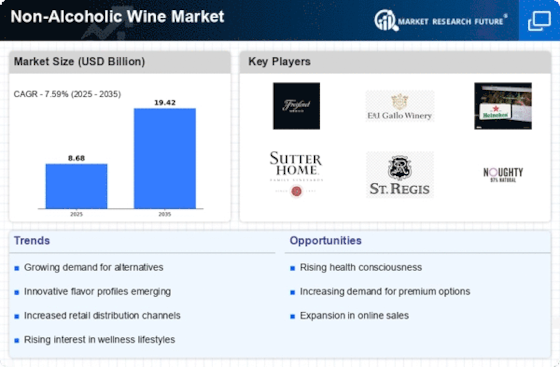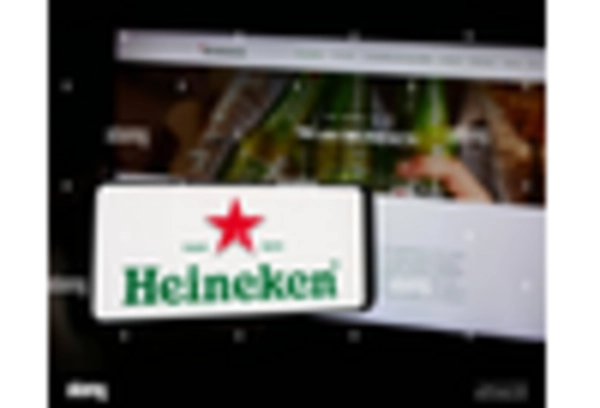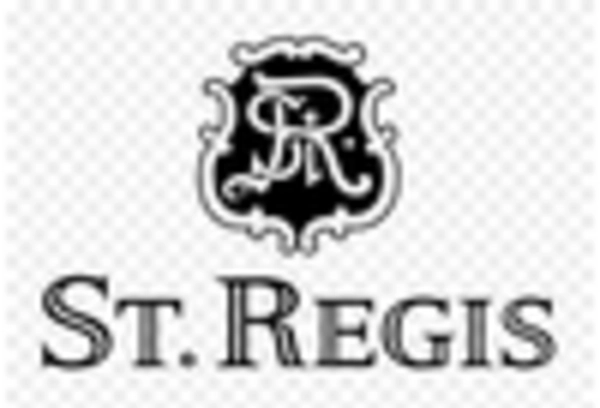The Non-Alcoholic Wine Market is currently characterized by a dynamic competitive landscape, driven by shifting consumer preferences towards healthier lifestyles and the increasing acceptance of non-alcoholic beverages. Key players such as Freixenet (ES), E&J Gallo Winery (US), and Heineken N.V. (NL) are actively shaping the market through innovative product offerings and strategic partnerships. Freixenet (ES) has positioned itself as a leader in the sparkling non-alcoholic segment, focusing on premium quality and unique flavor profiles. Meanwhile, E&J Gallo Winery (US) emphasizes a broad portfolio that caters to diverse consumer tastes, leveraging its extensive distribution network to enhance market penetration. Heineken N.V. (NL) is also making strides by integrating non-alcoholic options into its existing beer portfolio, thereby appealing to a wider audience and reinforcing its brand presence in the non-alcoholic sector.
In terms of business tactics, companies are increasingly localizing manufacturing to reduce costs and enhance supply chain efficiency. This approach appears to be particularly relevant in a moderately fragmented market where smaller players coexist alongside larger corporations. The collective influence of these key players is shaping a competitive structure that encourages innovation and responsiveness to consumer demands, thereby fostering a more vibrant market environment.
In August 2025, Freixenet (ES) launched a new line of non-alcoholic sparkling wines aimed at the premium segment, which is expected to attract health-conscious consumers seeking indulgence without the alcohol. This strategic move not only reinforces Freixenet's commitment to quality but also positions the brand to capitalize on the growing trend of premiumization in the non-alcoholic beverage sector. The introduction of this line could potentially enhance brand loyalty and expand market share in a competitive landscape.
In September 2025, E&J Gallo Winery (US) announced a partnership with a leading health and wellness influencer to promote its non-alcoholic wine range. This collaboration is likely to leverage the influencer's reach to engage a younger demographic, thereby broadening the consumer base. Such strategic alliances may enhance brand visibility and resonate with health-conscious consumers, aligning with current market trends that favor authenticity and lifestyle integration.
In July 2025, Heineken N.V. (NL) unveiled a new marketing campaign focused on its non-alcoholic beer and wine offerings, emphasizing sustainability and responsible consumption. This initiative reflects a growing trend towards environmental consciousness among consumers and positions Heineken as a forward-thinking brand. By aligning its marketing strategies with sustainability, Heineken may strengthen its competitive edge and appeal to a socially responsible audience.
As of October 2025, the Non-Alcoholic Wine Market is witnessing trends that emphasize digitalization, sustainability, and the integration of artificial intelligence in product development and marketing strategies. Strategic alliances are increasingly shaping the competitive landscape, allowing companies to pool resources and expertise. Looking ahead, competitive differentiation is likely to evolve from traditional price-based competition to a focus on innovation, technology, and supply chain reliability, as companies strive to meet the sophisticated demands of modern consumers.



















Leave a Comment